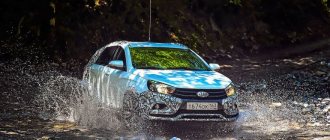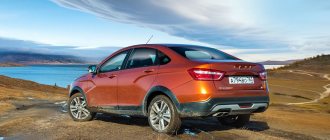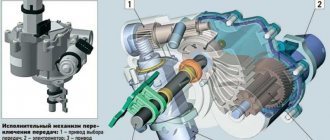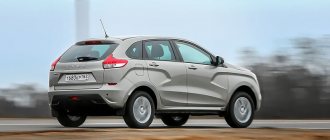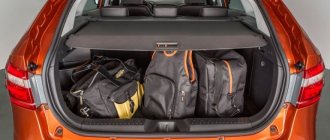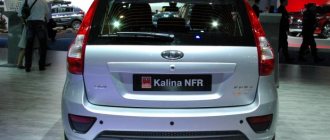06 October 2017 Lada.Online 21 133 14
On September 19, AVTOVAZ announced the price for Lada Vesta SW and Lada Vesta SW Cross, and all LADA dealers began accepting orders for these cars. At the end of September, AVTOVAZ provided station wagons for the first official test drive to leading auto media. The tests were carried out by real automotive experts in the city of Sochi.
Autoreview
It is beautiful, but not cheap, handles well, but accelerates poorly, practical, but voracious.
Suspension
:
- The suspension of the Lada Vesta SW and Lada Vesta SW Cross is different. On the cross version it is more “asphalt”.
- The suspension is denser, reactions are faster and more accurate, with it Vesta Cross rolls less and sways less.
- But it emphasizes waves and irregularities more strongly.
Control
:
- The elevated Cross controls more accurately and tastes better.
- The cross costs 830 thousand, but drives like a million. Reactions are fast and accurate, rolls are almost not felt.
Clearance
:
- Ground clearance is 203 mm - Crete never dreamed of this, and Kaptur is only one millimeter higher, but from experience there is more confidence in the Lada's passport clearance.
Noise insulation
:
- Unexpectedly good sound insulation (in a station wagon it is almost quieter than in a sedan).
- The roar of the engine is insipid, the turn signals click poorly, the horn snarls in the voice of a cold teenager.
Body:
- The rigidity of the station wagon body compared to the sedan dropped by only 100 Nm/deg and amounts to 17900-18900 Nm/deg. To compensate for the lack of a rigid rear shelf, the design has several additional elements that strengthen the body.
- We hung one wheel, all doors open and close without problems.
Fuel consumption
the Cross version in mountainous areas floated from 12 to 14 liters per 100 km.
Link #1 and link #2 for a test drive.
Prospects
As a result, AvtoVAZ managed to set a new personal record - the Lada Vesta turned out to be bright and competitive. The car opened new horizons for the Russian manufacturer - many countries wanted to import the new product, and all this with a promising 70% localization. In the first six months after the start of sales, Lada broke into the top 10 best-selling models according to the AEB (Association of European Businesses). Obviously, these figures are far from the limit, and soon a sports version will appear, which will also find its fans.
Behind the wheel
Suspension
:
- The regular Vesta SW station wagon has a rear suspension exactly like a sedan, but the characteristics of the springs and shock absorbers have been slightly revised for higher loads.
- Cross has different springs: thanks to them, the ground clearance is increased from 178 to 203 mm.
- This is the first production Lada with suspension like Subaru!
- There was not even a hint of a breakdown on any of the asphalt waves and holes that abound on the narrow mountain road to Solohaul (a famous rally stop!).
Engine and transmission
:
- The combination of a 122-horsepower engine and a manual transmission is fire! There is always enough engine, although there are three passengers in the car besides me and some luggage.
- The clutch does not require filigree footwork: you just release the pedal and go.
- Only occasionally did a slight itch irritate me, but this, as the engineers assured me, was a consequence of the fact that the engine calibration had not yet been completed.
Control
:
- The strength of the Cross is also that it handles perfectly - better than a sedan.
- ESC is triggered later than on a sedan, allowing you to drive a little more actively and slide longer without the intervention of an electronic guard (due to the fact that ESC is triggered, among other things, by the steering angle sensor + low-profile tires).
- Low-profile tires, with a stiffer sidewall, so when turning the steering wheel you deflect at smaller angles - the car changes course more readily and turns more actively into turns than on higher and softer tires.
- Active drivers will like it - you can afford a little more than usual. Living machine!
Brakes
:
- For ESP operation, disc brakes are preferable: they are faster, especially on rough roads.
Body
:
- The torsional rigidity of the body (on an empty car) is sufficient. The rear right wheel is a couple of millimeters off the ground, but all the doors, including the trunk, open easily.
Link to test drive.
Interior of Lada Vesta
The first thing you notice when you get into the cabin is the slight effort when opening the door, which is inherent in all foreign cars. For Russian cars, this is an innovation that would be nice to make a tradition. The console has become flattened and flatter.
Unfortunately, the developers skimped on plastic for the dashboard - the finishing materials are of very low quality. The leather-adapted steering wheel looks interesting, which makes it look more prestigious. The steering wheel itself is quite bulky and its width would suit a car of a larger weight category, but not a B-class sedan. The audio system control interface is quite convenient, but its sound and the sensor itself are a little let down.
A pleasant addition were sound speakers signaling the operation of various auxiliary systems; it is worth noting that not every car competing with the Lada has them. The gear shift lever became smaller than Largus's and acquired a more serious appearance, and the shift strokes acquired an acceptable distance. The handbrake is huge and clumsy-looking; moreover, its arc length is quite long, which will not allow everyone to push it to the limit. The last thing I want to pay attention to is the very small scales of the instruments; nothing prevented us from making them larger.
I was pleased with the spacious glove compartment, in which it is quite possible to put a set of food for a picnic, and the cooling function will not allow it to spoil. The original lighting unit and unusual inserts on the doors and center panel look in place, and also add those small touches that give the interior completeness and completeness.
There is a lot of free space in the rear seats, which is added by the backrest, which folds in a ratio of 60 to 40. A small minus is the lack of an armrest.
The volume of 480 liters provides the trunk with the necessary capacity, even despite its reduction by simple hinges. There is a spare wheel under the floor, but there is no, or rather too little, soundproofing covering.
Under the hood, everything is quite ergonomic, except for the overly massive engine cover, which could easily cover a two-liter engine. In general, there is practically no free space, it is well distributed and could hardly be done better.
Unlike Priora, the gas tank in Vesta has a volume of 55 liters, that is, 14 liters more.
The sedan is equipped with a climate control system, which is responsible for heating the windshield and engine. Thanks to this system, it is comfortable to be in the car even at very low temperatures outside the window.
Auto.mail.ru
Engine
:
- “Vesta” with the flagship engine (1.8 l, 122 hp), to put it mildly, did not please. In the mountains below the engine is empty, at the top it’s sad, the middle is so-so - no matter what speed you hold, sometimes the car not only didn’t want to accelerate on the climbs, it demanded to switch to a downshift. It’s doubly stressful to crawl along a country road - you have to play with the clutch like a jewel.
- In the morning, the cold engine upset me a couple of times with unexpected drops in traction.
Fuel consumption
:
- In mountainous areas, consumption was 12-13 liters of 92 gasoline. The on-board computer never showed anything below 9 liters the entire time.
Transmission
:
- I liked the Renault JR5 manual transmission: it shifts quite clearly, easily, does not buzz or howl.
Control
:
- Lada Vesta SW. This version resembles a sedan in its behavior on the road. The steering wheel is just as tight, with excitement it turns into a turn when releasing the gas and pleases with a lively response to steering turns.
- Lada Vesta SW Cross turned out to be even more interesting! The “off-road” version did not become any more rolly, retained an acceptable ride on low-profile 17-inch wheels, and even benefited in handling: the “Cross” has a cleaner steering wheel, a richer force on it, and the car is more stable in an arc during a turn.
- On the serpentine road, the front tires of the Cross were rubbing against the support cups of the suspension springs. We hope this is an isolated problem with our car.
- Never before have Russian station wagons driven so deliciously.
Link to test drive.
AutoVesti (Pavel Bludenov)
pros
:
- The suspension works great, the car is truly designed for Russian roads. Absorbs bumps well (better than Renault Kaptur).
- Excellent handling, even on bad roads.
Minuses
:
- Acceleration to 100 km/h is not impressive.
- The new instrument panel is blind, nothing is visible on it.
- AMT is not designed to be used.
- Multimedia system (the sun glares a lot and slows down).
- Below and above the engine behaves sadly.
- In 5th gear up a small hill the car does not accelerate at all.
Overall, the Lada Vestra SW turned out quite well. SW Cross seemed worse than a regular station wagon.
Autonews
Engine
:
- The new 1.8 liter engine is not very impressive on a mountain road. Vesta goes up strained, requiring a lower gear, or even two.
Transmission
:
- Well adjusted clutch. Everything works without vibrations.
- The gear ratios are also well chosen. The first two gears are well suited for city traffic, while the higher gears are good for highway driving and are economical. Vesta 1.8 drives confidently and accelerates well in the mid-speed zone, but is not distinguished by either powerful traction at the bottom or cheerful spin at high speeds.
Control
:
- A dense, slightly synthetic steering wheel, insensitive at small turning angles, modest rolls and understandable reactions, thanks to which you want and can drive the car along the Sochi serpentines.
Suspension
:
- Due to the redistribution of weight, the characteristics of the rear suspension have changed slightly (the rear springs of the station wagon have been increased by 9 mm), but this is not felt while driving.
- If the standard station wagon handles unevenness and bumps, albeit noticeably, but without crossing the line of comfort, then the Cross’s setup is clearly more asphalt.
- The Cross jumps over rocks without any suspension breakdowns. The standard SW is a little more comfortable in these conditions, but requires a little more careful choice of trajectory (since the ground clearance is lower).
Link to test drive.
Focus
It is focused on driving performance. Indeed, the engines that will be installed on Vesta are already well known from other AvtoVAZ and Alliance models. But driving performance is put at the forefront.
The chassis was what most interested the Autoreview experts.
The test drive took place in Spain, at the IDIADA training ground, which is not far from Barcelona (80 km). In addition, we were able to test the sedan on mountain serpentines.
The Spanish test site was not chosen by chance - this is where a significant part of automakers test their models. However, everything was done by AvtoVAZ employees. The publication's correspondents were able to not only observe, but also independently evaluate the car.
Test drive progress
Motor.ru
Engine
:
- According to the passport, thrust, far from the record 170 Nm, comes only to 3700 rpm, and up to 2000 the engine frankly sleeps. When driving up a small hill, we push the gearshift lever one, or even a couple of steps lower, and only after that we move on.
Transmission
:
- The gear lever is a bit long and not very clear.
Fuel consumption
:
- Consumption of 92 gasoline is 11-13 l/100 km.
Salon
:
- On the Vesta SW, the hard plastic on the door armrests will still rub your elbows when resting on them. But “Cross” masterfully knows how to hide all this behind an excellent design.
Link to test drive.
Let us remind you that AVTOVAZ previously talked about the features of the station wagon’s interior and trunk. This car uses a number of technical solutions that have not previously been widely used on LADA. And yet, this car has no direct competitors.
Keywords: Lada Vesta Cross
0 0 0 0 0 0
Share on social networks:
We accelerate and go
But a test drive of a Lada Vesta begins not with an inspection of the car, but with a ride in it. It is the ride that determines whether the car is really comfortable or whether it only seems so while it sits comfortably in the parking lot.
While the engine is idling, it is practically inaudible in the cabin, and this seems strange when you remember that the car is domestic. In addition, the first sounds appear at 3500 rpm, and at speeds exceeding 100 km/h, you can talk calmly without trying to shout over the car noise.
When taking the Lada Vesta car for a test drive, an interesting nuance emerged: the rated maximum speed is 178 km/h, and the speedometer showed more than 190 km/h! And this cannot be attributed to problems with the speedometer, since the GPS sensor showed that the speed was 186 km/h.
When driving a LADA with a robotic gearbox, after 160 km/h the hood opening sensor began to light up, while the hood itself remained safely closed. Testers believe that the hood was simply not installed quite accurately on a particular car, that is, this is not a defect of the brand, but simply an isolated error. This happens with pre-production cars. Moreover, nothing similar was found on another LADA Vesta - with a conventional manual transmission.
The Lada Vesta took a test drive in Italy, which is famous for its winding roads that are not particularly smooth. Steep descents and ascents are characteristic of Italian roads, especially in the mountainous regions of the country. Even on city streets there are an abundance of sharp turns, descents and ascents can compete with the mountains. But the Lada successfully passed all road tests, and the car passed even in the most unfavorable conditions at a fairly high speed. Testers claim that it’s all about the character of the car itself - they call it groovy! The car blends so well with the driver that it’s tempting to step on the gas. Moreover, imported electric power steering allows you to perform almost aerobatics, entering one turn after another. Also during the test, the neutral balance of the chassis was noted, and the Lada Vesta could go into a skid solely with the help of the handbrake. In addition, everything is under the control of the ESP stabilization system - it turns off only at low speeds, when skidding becomes almost impossible.
